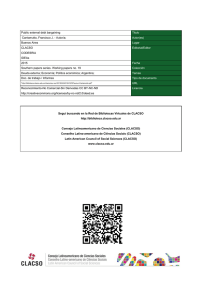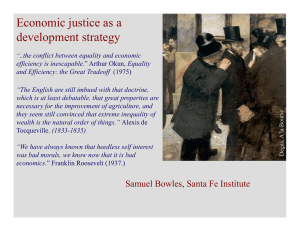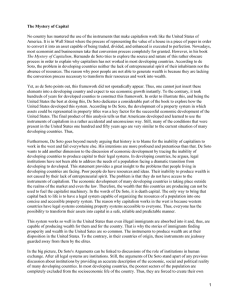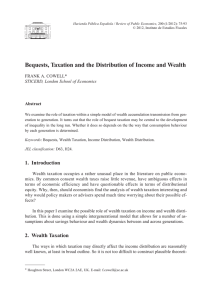two-thirds of everything
Anuncio
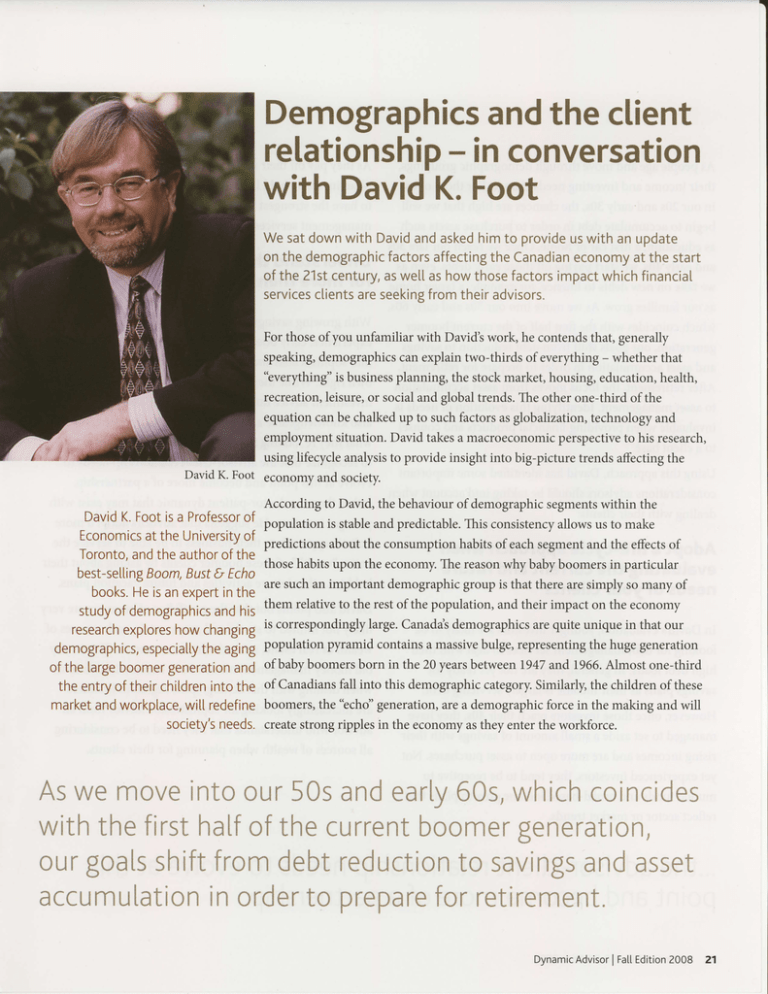
Demographics andthe client - in conversation relationship with DavidK. Foot Wesatdownwith Davidandaskedhimto provide uswith an update on the demographic factorsaffectingthe Canadian economyat the start of the 21stcentury, aswe[[ashowthosefactorsimpactwhichfinancial services clientsareseeking fromtheiradvisors. For those of you unfamiliar with David'swork, he contendsthat, generally speaking,demographicscan explain two-thirds of everything - whether that "everything" is businessplanning, the stock market, housing, education,health, recreation,leisure,or social and global trends. The other one-third ofthe equation can be chalked up to such factors asglobalization,technology and employment situation. David takesa macroeconomicperspectiveto his research, using lifecycle analysisto provide insight into big-picture trends affecting the David K. Foot economy and society. According to David, the behaviour of demographicsegmentswithin the DavidK.Footisa Professor of population is stableand predictable.This consistencyallows us to make Economics at the University of predictions about the consumption habits of eachsegmentand the effectsof Toronto, andtheauthorofthe those habits upon the economy.The reasonwhy baby boomers in particular best-selling Boom,Bust& Echo are such an important demographicgroup is that there are simply so many of books. Heisanexperlinthe studyof demographics andhis them relativeto the rest of the population, and their impact on the economy research explores howchangingis correspondinglylarge.Canada'sdemographicsare quite unique in that our demographics, especiatty theagingpopulation pyramid containsa massivebulge, representingthe huge generation of the largeboomergeneration and of baby boomers born in the 20 yearsbetweenlg4T and 1966.Almost one-third theentryof theirchildren intothe of Canadiansfall into this demographiccategory.Similarly, the children of these "echd'generation, are a demographicforce in the making and will marketandworkptace, wit[redefineboomers,the societv's needs.createstrong ripples in the economy asthey enter the workforce. Aswe movei n t oo u r5 0sa n de a rl y6 0 s,w h i chco i ncides withthefirsthalfof thecurrent generation, boomer ourgoalsshiftfromdebtreduction to savings andasset accumulation in orderto prepare for retirement. Dynamic AdvisorI FattEdition2008 21 As peopleageand move through demographicgroupings, As they pay offtheir mortgagesand approachretirement, their income and investingneedschange.For thoseof us older investorshold larger investment portfolios and tend in our 20s and early 30s,the chancesare high that we will to havethe strongestneed for a fuller spectrum of wealth begin to accumulatedebt in order to purchaseassetssuch managementservices. aseducation,a first car or home. Once we reachour late 30s and early 40s,we start paying offthose early debts,even as we take on new debts to finance,for example,a larger home Understandthat boomersare looking for morethan stock advice as our families grow. As we move into our 50s and early 60s, which coincideswith the first half of the current boomer With growing savingsportfolios and yearsof investing generation,our goalsshift from debt reduction to savings experience,early boomers havehad the time to develop and assetaccumulation in order to preparefor retirement. into sophisticatedand educatedinvestorsin their After retirement, the focus moves from assetaccumulation own right. While they havethe most need for serious to assetmanagement.Identifying this evolution of needsis investment advicedue to the sizeof their assets,they are invaluablewhen providing financial products and counsel also knowledgeableand mature enough to understand to a client base. what they're looking for. David believesit's important Using this approach,David has identified some important considerationsadvisorsshouldbe taking into accountwhen dealingwith their clients: Adopt a life-cycle approachwhen evaluatingthe current andfuture needsof your clients to recognizethat the advisor-clientrelationshipneedsto evolveat this point and becomemore of a partnership, rather than the doctor-patient dynamic that may exist with younger investors.He suggeststhat advisorsadopt a more holistic approachto their businessto be able to servicethe "wealth'of entire theseboomer clientsby askingabout their hobbies,other leisure activities and future vacation plans. David also points out that the portfolios of boomers are very In David's evaluation,younger investorsare likely to be likely not limited to stocksand may contain such sourcesof looking for debt managementservicesto deal with their wealth as real estate,art and other investments.This is why high debt loads. In general,they are not yet ready for old money managementmodels havebecomeinsufficient savingsplans as their income is largely servicing debt. when dealingwith this demographicsegment.Boomers However,once those investorsreachtheir 40s,they have are increasinglylooking for sophisticatedadvice from an managedto set asidea small amount of savingswith their advisorwho understandsthat they needto be considering rising incomesand are more open to assetpurchases.Not all sourcesof wealth when planning for their clients. yet experiencedinvestors,they tend to be receptiveto mutual funds and broad-basedincome growth plans that reflectsectoror market trends. ...the advisor-client relationship needs to evolve at this pointandbecome moreof a partnership. 22 Dynamic Advisor 2008 I FattEdition Offer wealth managementservices for the entire family today'sboomers,may havespecial insuranceneedsfor such assets asvacationproperties,boatsand artwork. Approximately one in seven David believesthat Canadians are moving increasinglyto an intergenerationalmodel of financial planning as growing life expectancieshave given rise to the need for ensuring the financial health of all generationsin the family. This is often expressedin the desirefor tax planning within the family. Helping ensurethat families are paying the appropriatelevel of overall taxesis the job of the advisor, though it should be noted that this Lookingforward Looking ahead 10 to 20 years,David predicts that interest ratesshould Canadiansowns a cottageor vacation experiencemoderateincreases, though remain at relatively low property.Thesesameinvestors, levels.This is becausethe echo though, havea diminishing desire generation,born between1980and for life insuranceasthey areliving perhaps,grandchildrenwho should 1995,are entering the workforce and into their prime borrowing years. However,at the sametime, boomers will be retiring their own debt, which should exert a moderating influence own life insurance. on rising interest rates. longer,more activelives.Manymay want to convert their policiesinto annuities.It is their children and, As for economic growth, David believesit will continue to slow down, which is inevitable, given and society. our aging population. This should easepressureon commodities. David is quick to point out, though, that declining GDP growth will Another areaof interestin family not necessarilytranslateinto wealth managementis insurance, falling per capita income. As long as GDP growth exceedsthe slower population growth, per capita is distinct from tax avoidance,which David feelsis a disserviceto clients which, accordingto David, is also affectedby demographic factors. Investors begin to require insurance incomes can continue to increase. with the purchaseof their first major asset,which typically occurs in their 30s arid.4)s Older investors, suctr as Dynamic AdvisorI FaltEdition2008 23






